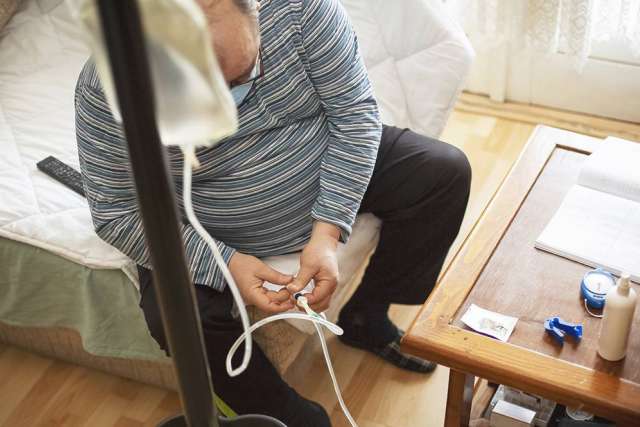The COVID-19 pandemic has greatly complicated the lives of people who require kidney dialysis. Contracting the virus could worsen their overall health and lead to complications. Dialysis patients who do develop the infection must receive dialysis at special centers established for COVID-19 patients.
The pandemic serves as a reminder of the advantages of receiving dialysis at home, according to , a UCLA nephrologist and expert on home dialysis. In addition to reducing the risk of COVID-19 exposure, home dialysis offers other benefits and is gaining favor in some parts of the country, he says.
“In-center dialysis is the traditional way most patients are treated,” he says. “But the push now is to get patients on home dialysis.”
Kidney dialysis is required when the kidneys are no longer functioning properly. Dialysis filters the blood to remove waste products. Ideally, Dr. Rastogi says, patients with kidney failure should undergo kidney transplantation. But since it can take some time to receive a suitable donated kidney, dialysis saves lives and serves as “a bridge to transplantation,” he says.
About 468,000 Americans receive kidney dialysis with only about 10 percent taking advantage of home dialysis. However, at UCLA, about one-third of dialysis patients choose home dialysis. In Dr. Rastogi’s practice, the number is between 50 to 60 percent.
“Our approach is that the patient should be on home dialysis,” he says. “Patients should ask themselves, why am I not on home dialysis?”
There are several types of home dialysis including home hemodialysis, which is like in-center dialysis but performed at home, and peritoneal dialysis. In peritoneal dialysis, a catheter is inserted in a small abdominal opening. The catheter connects to a machine to conduct the exchange of fluids.
Home dialysis has a number of advantages over in-center dialysis, Dr. Rastogi says.
“Most dialysis patients have to go to a center three or four times a week. Home dialysis gives patients more flexibility and control,” he says. “They can pursue work or school, and it’s easier to travel.”
Moreover, studies show that kidney function is better maintained with proper home dialysis, he says.
“Patients also feel better,” he says. “When you do in-center dialysis three times a week, there are ups and downs; periods of fatigue and not feeling well.”
Home dialysis requires training that typically lasts two or three weeks. UCLA offers both a New Inpatient Dialysis Start (NIDS) program to help educate new dialysis patients on their options, as well as a Transitional Care Unit to assist patients in-home dialysis training and education.
“Patient selection is very important,” he says. “You have to train them properly. You have to make sure patients can do it and understand the basics.”
About one in three patients who try home dialysis will revert to in-center dialysis at some point, he says. Some of the problems that derail home dialysis are technical problems with the machines or infection. But proper up-front training and patient support can dramatically improve long-term success, he says.
The COVID-19 pandemic has provided a compelling reason for in-center dialysis patients to convert to home dialysis, Dr. Rastogi says. UCLA Health nephrologists can answer questions about home dialysis options.
“We have home dialysis patient ambassadors who will talk to you," he says. "There is no better time than now to be in in-home dialysis.”
Citations:




